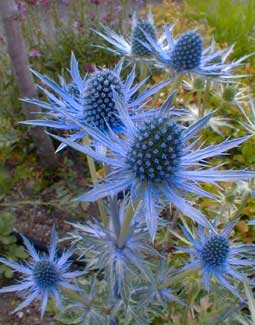 'Sapphire Blue'
'Sapphire Blue'
Sea Holly
'Sapphire Blue' is a garden cultivar with the largest flowers of any sea holly. It is not invasive. The wild form of E. planum is capable of being too aggressive in the Northwest, but 'Sapphire Blue' is a sterile hybrid.
Its phantasmagoric blooms start out green in May, but by June darken to an intense blue, so intense they almost look spray-painted. The blooms last all of summer, to as late as September. The blooms look like teasils or thistles, with a star-like collar of spiky bracts at the base of each bloom.
'Sapphire Blue' was bred from European Eryngium to enhance the metalic blue coloration to the leaves & flowers. The breeder was Wouter Ruigrok of Hillegom, Holland, whose creation was first distributed by Blooms of Bressingham, an English nursery with a marvelously apropos name, since it is run by the Bloom family.
It forms a taproop therefore resents being moved once it is established. Still, division is possible for an old clump, so long as one digs down very deeply to keep the taproots intact. A single taproot divided laterally frequently regenerates both parts completely.
The sunnier the location for 'Sapphire Blue,' the bluer the clumps become. The silvery blue of the teasil-like blooms extends down the stems over the leaves, providing one of the few truly blue-foliaged plants.
It thrives in poor dry soil low in fertility, reaching a foot & a half ot two feet of height. It remains bluist when never fertilized, as richer soil will only make it taller with weakened stems, without improvement to the flowers.
It does well in zones 5 through 9. In our zone it is nearly an evergreen. By leaving the seedheads intact when they begin to dry out in autumn, these too will last long into winter garden with considerable ornamental appeal, but without risk of spreading.
It provides excellent fresh-cut flowers for bouquets, or is easily dried for extremely long-lasting flower arrangements.